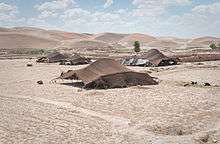Pashtunization
Pashtunization (Pashto: پښتون جوړونه), also called Pathanization,[1][2][3] is a process of cultural or linguistic change in which someone or something non-Pashtun becomes acculturated to Pashtun influence. Pashtuns are the largest ethnic group in Afghanistan and second-largest in Pakistan.
| Part of a series on |
| Pashtuns |
|---|
| Kingdoms |
| Religion |
Dynasties and settlements

People become Pashtunized when they settle in Pashtun-dominated areas and adopt Pashtun culture and language.[5] Pashtunization is a specific form of cultural assimilation and has been taking place in Pashtun-populated regions of Afghanistan and Pakistan for several centuries.
"In the eighth and ninth centuries, ancestors of many of today's Turkic-speaking Afghans settled in the Hindu Kush area (partly to obtain better grazing land) and began to assimilate much of the culture and language of the Pashtun tribes already present there."[6]
— Craig Baxter, Library of Congress Country Studies
The Khalaj were originally a Turkic tribe which had long domiciled in the Ghazni, Qalati Ghilji (also known as Qalati Khalji), and Zabulistan regions of present-day Afghanistan. They intermarried with the local Pashtuns and gradually adopted the Pashtun culture. Najib Bakran's geography, Jahān Nāma (c. 1200-1220), described the Khalaj as a "tribe of Turks" that had been going through a language shift. Some of them left the area during the Mongol invasion of Central Asia towards the Indian subcontinent, where they built empires such as the Khalji dynasty of Delhi. Because of their language shift and Pashtunization, the Khalaj were considered to be Pashtuns (Afghans) by the Turkic nobles of the Delhi Sultanate.[7][8][9][10][11]
Pashtunization may also refer to the settling of Pashtun tribes onto lands where non-Pashtun tribes live[12] or more broadly the erosion of the customs, traditions and language of non-Pashtun peoples due to the political power and regional influence of the Pashtuns.[13] This occurred in the Peshawar sub-region in the early 16th century, during the period of the Suri dynasty of Delhi.[14] It intensified in the mid-18th century under Pashtun emperor Ahmad Shah Durrani, when he conquered non-Pashtun territories and established the Durrani Empire.[12] During the reign of Abdur Rahman Khan in the late 19th century, some Pashtuns settled in the north of the country, while Tajiks from the north were brought to the south. This was done for political reason, mainly to prevent Russian invasion. In the meantime, thousands of Hazaras left Hazarajat to settle in Quetta (now in Pakistan) and Mashad in what is now Iran.[15]
Modern influences
Some Pashtunization attempts were later made in the early part of the 20th century by the Musahiban.[16][17] Many non-Pashtuns living in close proximity with Pashtuns have been Pashtunized.[5] For example, in the central Ghor Province, some southern groups of Aimaqs have adopted Pashto language.[18] In the eastern Laghman and Nangarhar Provinces, many Pashai people are bilingual in Pashto and consider themselves ethnic Pashtuns.[19][20]
See also
Notes
- Nayak, Pandav (1984). Pakistan, society and politics. University of Michigan: South Asian Publishers. p. 189.
- Ahmed, Akbar S. (1997). Pakistan Society: Islam, Ethnicity, and Leadership in South Asia. Oxford University Press. p. 108. ISBN 978-0195778373.
- Institute of Objective Studies (New Delhi, India) (1989). Journal of Objective Studies, Volume 1. Institute of Objective Studies. p. 39.
- Dupree, Nancy Hatch (1970). An Historical Guide to Afghanistan. First Edition. Kabul: Afghan Air Authority, Afghan Tourist Organization. p. 492. Retrieved 17 June 2012.
- Banting, Erinn (2003). Afghanistan the People. Crabtree Publishing Company. p. 14. ISBN 0-7787-9336-2. Retrieved 2010-08-27.
- "Islamic Conquest". Craig Baxter. Library of Congress Country Studies on Afghanistan. 1997.
- Chaurasia, Radhey Shyam (2002). History of medieval India: from 1000 A.D. to 1707 A.D. Atlantic Publishers & Distributors. p. 28. ISBN 81-269-0123-3. Retrieved 2010-08-23.
The Khiljis were a Turkish tribe but having been long domiciled in Afghanistan, and adopted Afghan habits and customs. They were treated as Afghans in Delhi Court
- Yunus, Mohammad; Aradhana Parmar (2003). South Asia: a historical narrative. Oxford University Press. p. 97. ISBN 0-19-579711-6. Retrieved 2010-08-23.
- Cavendish, Marshall (2006). World and Its Peoples: The Middle East, Western Asia, and Northern Africa. Marshall Cavendish. p. 320. ISBN 0-7614-7571-0. Retrieved 2010-08-23.
- "Khalji Dynasty". Encyclopædia Britannica. Encyclopædia Britannica Online. Retrieved 2010-08-27.
- Thorpe, Showick Thorpe Edgar (2009). The Pearson General Studies Manual 2009, 1/e. Pearson Education India. p. 63. ISBN 978-81-317-2133-9. Retrieved 2010-08-23.
- Meri, Josef W. (2006). "Sedentarism". Medieval Islamic Civilization: An Encyclopedia. Taylor & Francis. p. 713. ISBN 0-415-96691-4.
- Lansford, Tom (2003) A Bitter Harvest: US foreign policy and Afghanistan Ashgate, Aldershot, Hants, England, ISBN 0-7546-3615-1, page 16: "The modern history of Afghanistan has witnessed a "Pashtunization" of the state as the customs, traditions and language of the Pashtuns have combined with the groups political power to erode the distinctive underpinnings of Afghanistan's other groups.FN20". FN20 cites: US, Department of the Army, Afghanistan: A Country Study, 5th ed. reprint (Washington, DC.: GPO, 1985) page 108.
- "the Pashtun conquest of the Peshawar subregion in the early sixteenth century meant the Pashtunization of the area", Arlinghaus, Joseph Theodore (1988) The Transformation of Afgham Tribal Society: Tribal Expansion, Mughal Imperialism and the Roshaniyya Insurrection, 1450-1600 Thesis/dissertation, Duke University, p.17, OCLC 18996657
- O. Roy, Ethnic Identity and Political Expression in Northern Afghanistan, in Muslims in Central Asia: Expressions of Identity and Change, 1992, ISBN 0-8223-1190-9.
- Rubin, Barnett R. (2002). The fragmentation of Afghanistan: state formation and collapse in the international system. Yale University Press. p. 66. ISBN 0-300-09519-8. Retrieved 2010-08-27.
- Atabaki, Touraj; John O'Kane (1998). Post-Soviet Central Asia. Tauris Academic Studies in association with the International Institute of Asian Studies. p. 208. ISBN 1-86064-327-2. Retrieved 2010-08-27.
- Vogelsang, Willem (2002). The Afghans. Wiley-Blackwell. p. 18. ISBN 0631198415. Retrieved 23 January 2012.
- Pashai, Ethnic identity in Afghanistan, on nps.edu
- http://www.sil.org/asia/ldc/parallel_papers/ju-hong_yun.pdf